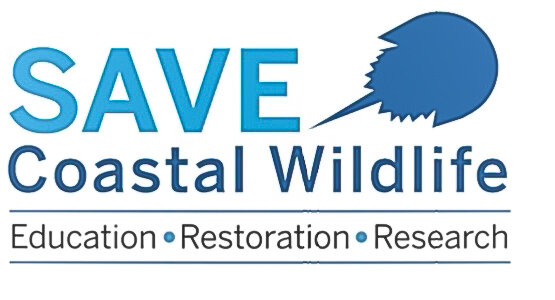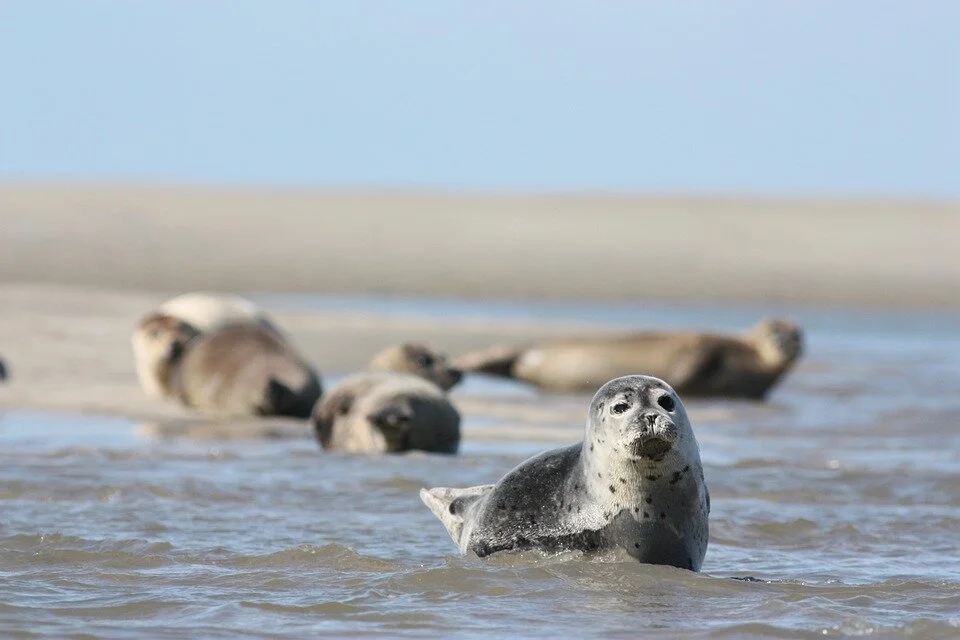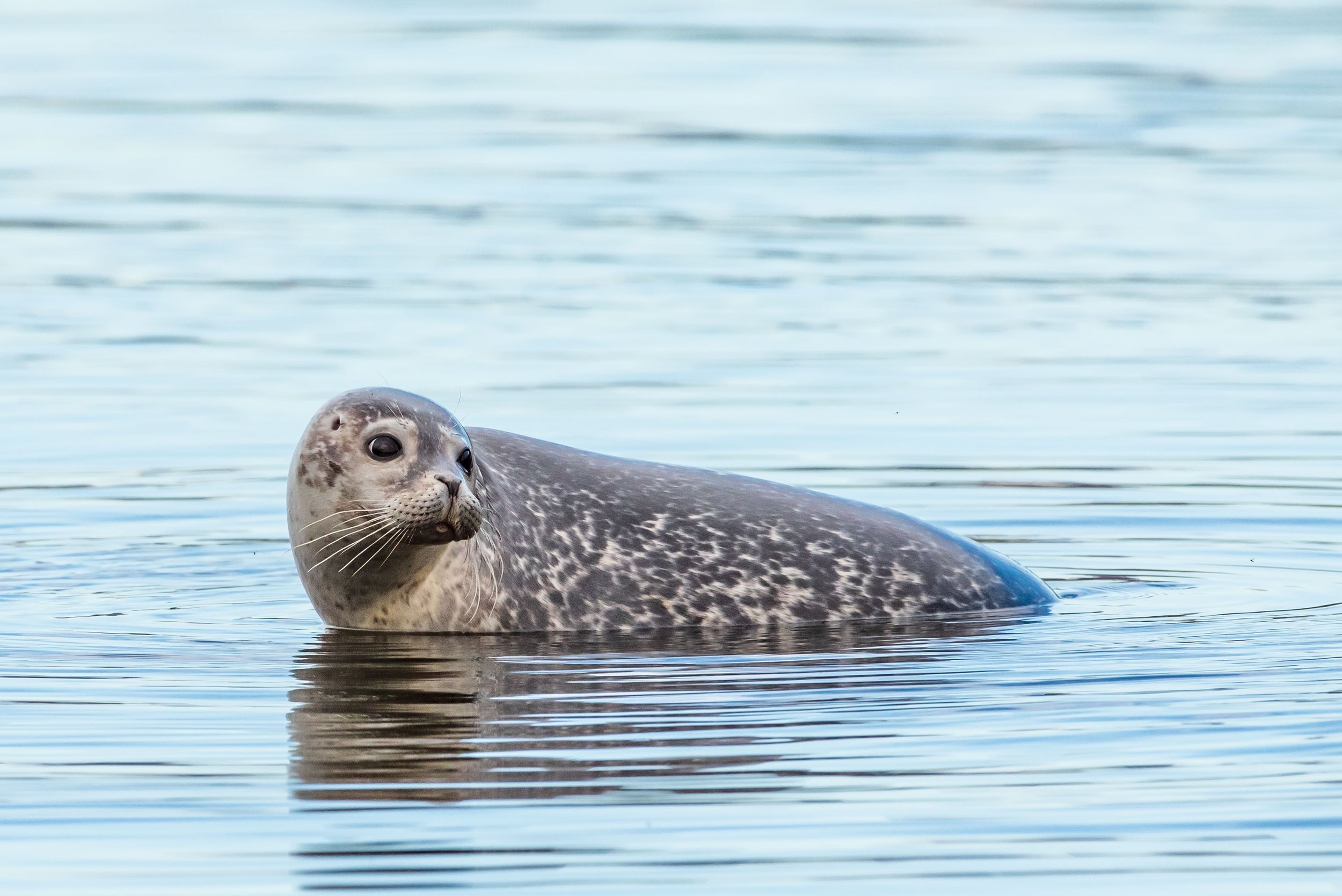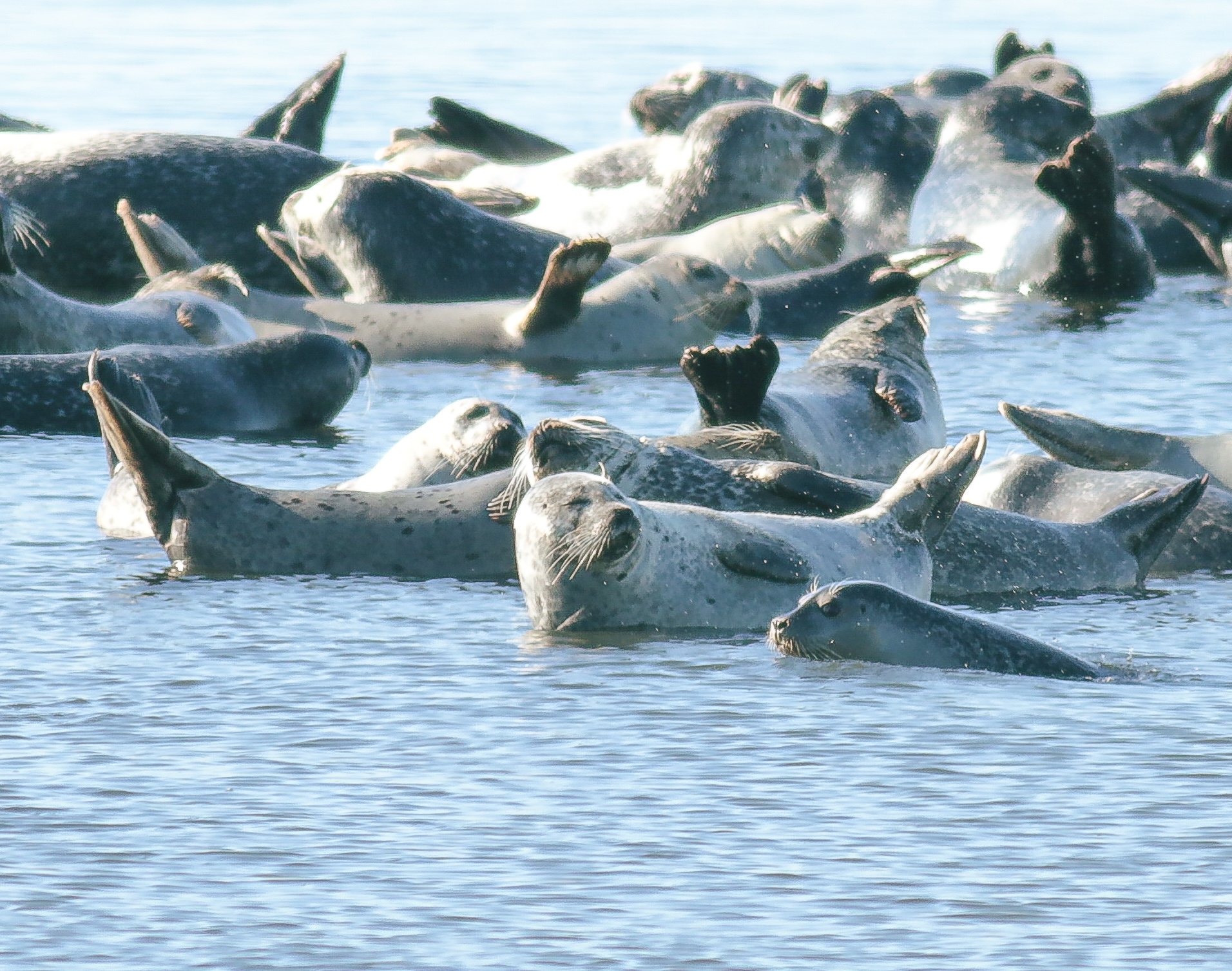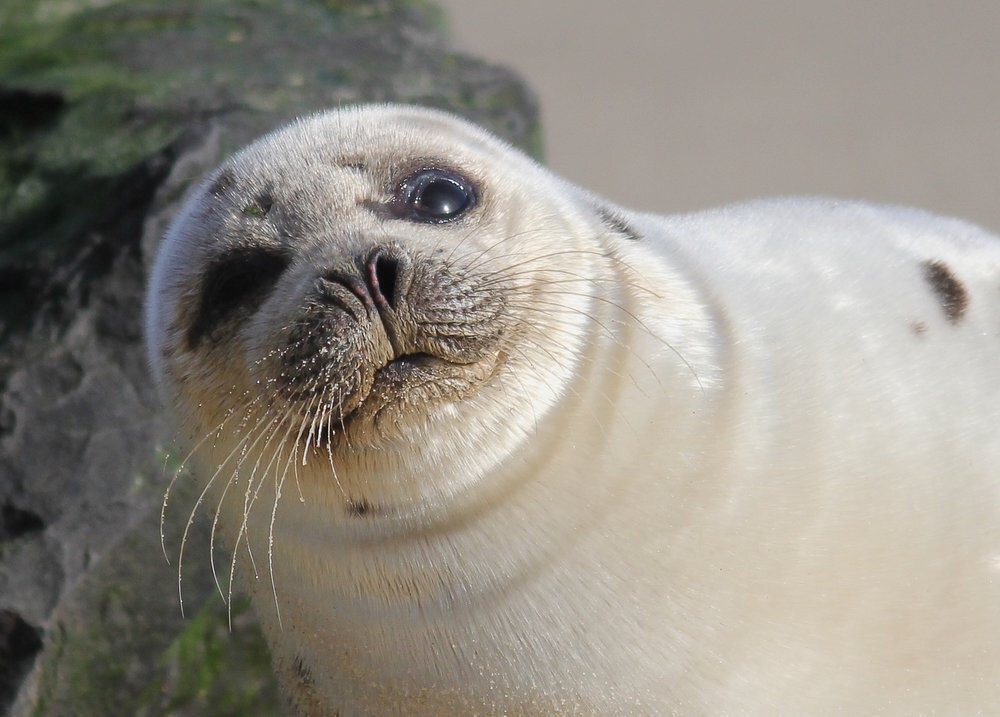A Guide To Seals Along The Jersey Shore!
Harbor Seal
The Jersey Shore is a seasonal home to several species of seals or pinnipeds during the late fall, winter, and early spring; sometimes even year-round as every so often a juvenile seal might be spotted during the summer. Below the list of seal watching guidelines is a description of the most common seal species observed along the Jersey Shore every year; and a list of frequent threats to seals.
Watch these amazing marine mammals live their lives in their natural habitat, but please be respectful of wildlife and always watch wildlife from a distance.
Seal Watching Guidelines
When viewing seals, please remember to watch wildlife from a distance and always respect wildlife. Please remember the following rules when observing seals along the Jersey Shore:
Please view and photograph seals from a distance of at least a 150 feet away, but the farther away the better. Seals are sensitive to being disturbed and a person approaching a seal more closely can cause this animal to become stressed, sick, or leave the area, perhaps even permanently. How do you know if you are too close? If a seal starts to vocalize, starts looking directly at you, moves away, waves flippers or increases their yawning. These signs are telling you to move away now.
If an individual or a herd of seals moves towards the water or there is a hurried entry into the water by many individuals, you should retreat slowly and carefully.
Use binoculars or a spotting scope so you can get a better view without getting too close.
Do not try to touch, feed, harass, bother, annoy, or take a selfie with a seal.
Why do we ask you to follow these guidelines?
Seals are less confident on land compared to the water. If a seal feels threatened (even if the threat is real or not), the animal will return to the water, where a seal is more agile and feels secure. When disturbed, seals will rush to the water and can injure themselves on rocks, driftwood, glass, abandoned fish hooks, or other materials. Claws can also get trapped on debris. This disturbance can be caused by noise and sudden movement from people, other animals (especially dogs or other domestic animals), boats, kayaks, and wind-surfers. Disturbance interrupts their daily routine, causes distress and uses up vital energy. If a disturbance continues, seals may stop using an area altogether.
Adult Gray Seal
WHO DO YOU CALL FOR HELP!
If you see a seal that appears injured, entangled, sick, or being harassed by a person, in New Jersey call the Marine Mammal Stranding Center at 609-266-0538. In New York City, call the Riverhead Foundation for Marine Research and Preservation at 631-369-9829. These two organizations have the authority to help stranded or sick marine mammals and sea turtles. Wildlife experts with the help of trained volunteers will determine if an animal is in need of medical attention, needs to be moved from a populated area, or just needs time to rest.
If you discover a sick, injured, stranded or dead seal or a marine mammal in another state, please contact your local stranding network. Information can be found here.
Field Guide
Harbor Seal (Phoca vitulina)
Harbor or common seals are the most widespread of the pinnipeds to visit the Jersey Shore every winter. These curious animals can sometimes be found not only along an ocean or bay beach, but sometimes on a pier or other structure far up a river, including the Delaware River and the Hudson River, as they rest after foraging for food.
Size: Adults 5.6 to 6.3 feet long; males slightly larger than females. Adult harbor seals can weigh up to 285 pounds. At birth a seal is approximately 30 inches long.
Body and color: Round head with a short, concave dog-like snout. Nostrils form a V-shape when viewed head on. The color of their coat can be quite variable, from dark to light, silver to reddish tan; and with light and dark speckling.
Harbor seals hauled out to rest, re-heat and digest their food.
Behavior: A single seal can be spotted on a beach or several dozen or more can be observed at a haul-out site to rest, digest food, and warm bodies under the sun.
Habitat: Will use sandy or rocky sites for haul-out places to rest. Usually protected from disturbances.
Diet: Variety of fish, shellfish, squid, octopus.
Life history: Sexually mature at 3 to 6 years. Breeds May and July after pups weaned. Single pup born every year between April to June mostly along beaches in Maine and eastern Canada.
Life span: About 25 to 30 years
Status: Most common seal in U.S. Atlantic region; population increasing.
Grey Seal (Halichoerus grypus)
Gray or grey seals are one of the largest seals to visit the Jersey Shore. Female gray seals are about 7.5 feet long and weigh about 550 pounds, while males are about 10 feet long and weigh about 880 pounds. They are sometimes called "horseheads" (adults males in particular have large, horse-like heads) because of their large, curved noses.
Size: Adult males 10 feet long; adult females 7.5 feet long. At birth a grey seal is about 3 feet long.
Body and Color: Males are generally dark with irregular light patches. Females are lighter in color with dark spots. All grey seals have a distinctive horse-like head with broad arching snout. Nostrils form a W-shape. Sexually dimorphic - adult males are much larger than females and with a thicker neck, broader head and darker color coat.
A grey seal observed among a large group of harbor seals at rest.
Behavior: Can form large rookeries to rest. Some will associate with harbor seals.
Habitat: Will use sandy or rocky sites as haul-out locations.
Diet: Variety of fish, shellfish, squid, octopus, crabs.
Life history: Females sexually mature at 3 to 5 years; males 4 to 8 years. Breed in winter after pups are weaned along beaches from eastern Canada to Cape Cod.
Juvenile Grey seal observed at Sandy Hook NRA.
Life Span: 25 to 35 years.
Status: In U.S. waters, there is one stock of gray seals, the western North Atlantic stock. U.S. NOAA Fisheries’ scientists are not currently able to estimate the number of seals in this stock, but there is evidence from Canada to suggest that the over all population is increasing.
WHy Are Haul out Sites important to protect?
Harbor and Grey seals haul out (come out of the water) almost daily to rest, digest their food, and to warm up. They cannot maintain their body metabolism if they stay in cold water all the time.
Harp Seal (Pagophilus groenlandicus)
Harp seals are arctic seals; more common from the Gulf of St. Lawrence and northward throughout the cold waters of the North Atlantic and Arctic Oceans. Harp seals are rare visitors to the Jersey Shore, but occasionally our coastline is visited by juvenile harp seals or even more infrequently by large non-mating adults.
When a harp seal does visit the Jersey Shore, it tends to be solitary and very tired from a long journey up north.
Juvenile Harp Seal
Size: Adults from 5.6 feet to 6.3 feet long, males slightly larger than females. Weighs about 260 to 300 pounds. At birth a young harp seal is 2.5 to 3 feet long.
Body & Color: Adults are silver-gray in color with a black face and a wishbone shaped “harp” on the back. 1 to 3 or 6 year old juvenile harp seals have an irregular blotched coat that developed into an adult harp pattern with each annual molt. The body has a small and sleek head. Well developed claws on front flippers.
Behavior: An ice-associated seal and highly mobile in search of food. Usually a single harp seal is seen resting on a beach and is not associated with other seals of different species.
Habitat: Closely related to sea ice and snow. Pups are born on pack ice up north.
A sub-adult harp seal observed along Sandy Hook Bay, NJ.
Diet: Crabs and fish.
Life history: Sexually mature at 4 to 7 years. Breeds in March after pups are weaned. Single pup born every year between February and March.
Life span: Up to 30 years.
Status & Threats: According to NOAA Fisheries, based on the most recent survey, NOAA scientists estimate that there are about 7 million seals in the North Atlantic Stock. Harp seals are commercially hunted in eastern Canada since the mid-1800s for fur and food from a government-set harvest. Harp seals are also threatened from Global Climate Change, as they rely on the availability of sea ice for giving birth, nursing pups, and molting. Consequently, harp seals are sensitive to the timing and extent of sea ice formation and breakup.
Adult Harp Seal
Human Threats to Seals
The following list of threats is from NOAA Fisheries
Entanglement
Seals can become entangled in fishing gear and other types of marine debris resulting in seals swimming off with the gear attached or becoming anchored. Once entangled, seals may drown if they cannot reach the surface to breathe, or they may drag and swim with attached gear for long distances. This can ultimately result in fatigue, compromised feeding ability, or severe injury, which may lead to reduced reproductive success and death.
Human-Caused Injuries
Feeding (or trying to feed) a seal is harmful and illegal. It changes their natural behaviors and makes them less wary of people and vessels. They learn to associate humans with an easy meal and change their natural hunting practices—for example, they take bait catch directly off fishing gear. Sometimes they fall victim to retaliation (such as shooting) by frustrated boaters and fishermen.
They may also be disturbed or harassed by the presence of humans and watercraft. Harassment is illegal and happens when any act of pursuit, torment, or annoyance might injure them or disrupt their behaviors. Remember to share the shore with seals for their safety and yours.
Chemical contaminants
Contaminants enter ocean waters from many sources, including oil and gas development, wastewater discharges, urban runoff, and other industrial processes. Once in the environment, these substances move up the food chain and accumulate in predators near the top of the food chain such as seals. These contaminants accumulate in a seals’ blubber stores, threatening their immune and reproductive systems.
A sick juvenile harp seal
Oil spills and energy exploration
Oil spills can harm seals. If exposed to oil, a seal’s fur can no longer repel water. This makes it difficult for the seal to swim, float, and keep warm. Inhaling or swallowing oil can also damage a seal’s respiratory, digestive, reproductive, and central nervous systems. Oil can also irritate or burn the seal’s skin.
Vessel Interactions
Seals are susceptible to water vessel and land vehicle impacts. Inadvertent vessel strikes can injure or kill seals. All seals are vulnerable to vessel collisions throughout their range, but the risk is much higher in some coastal areas with heavy vessel traffic.
Do seals compete with commercial fishermen?
A 2015 article published in National Fishermen tells us that research done by Queen’s University Belfast, Northern Ireland, shows that seals don’t have a significant impact on herring, mackerel, cod, haddock, whiting and 30 other species caught for commercial purposes. The perception by fishermen that significant declines in abundance of commercially and recreational exploited species comes about when seals or other wild animals directly remove target species is not factual. Evidence is scarce to support this argument.
One important reason for the decline of fish stocks is not that there are too many wild animals or biodiversity in the sea, but that there are too many fishing nets, lines, cages, and ghost gear in the water. It is estimated as of May 2019 that the global fishing fleet has grown from 1.7 million vessels in 1950 to 3.7 million in 2015, not including illegal and pirate fishing fleets.
A bottom trawl is a type of fishing net that's pulled along the seafloor. Fishermen commonly use bottom trawls to catch shrimp and bottom-dwelling fish like halibut and flounder. However, in addition to these target fish, the nets also catch a variety of ocean life that's usually thrown back dead or dying.
This increase in the commercial fishing industry along with an increase in modern technology, such as sonar and large nets and long lines, has been called the most destructive activity on earth and has put intense pressure of fish stocks worldwide. Two-thirds of the worlds fish are overfished and depleted according to a 2012 UN Food and Agricultural Organization study. Only a third of global fisheries overall are fished at levels that allow fish to repopulate.
Modern commercial fishing operations often use reckless techniques to catch fish including a system called “bottom trawling,” which takes place when a fishing boat drags a giant net across the ocean floor. A single trawling net can be up to 450 feet in length, which is the distance of 1.5 football fields. The average bottom trawl opening is 40 to 60 feet wide and 8 to 10 feet tall. Bottom trawlers typically fish from 1 to 40 miles offshore, which is the very same coastal-ocean location as the foraging areas for many species of seals, including harbor and grey seals.
A trawling net moves along the bottom of an ocean to scrape up fish—and anything else in their path—wreaking havoc on delicate ecosystems and aquatic habitats. The United Nations estimates that up to 95% of global ocean damage is a direct result of bottom trawling. Modern fishing and overfishing are also closely tied to bycatch—the capture of unwanted sea life while fishing for a different species. Bycatch occurs because a trawling net also traps everything larger than the net's mesh size, which often includes juvenile fish, but also sometimes sharks, marine turtles and small cetaceans, such juvenile whales, dolphins, and porpoises.
The world’s ocean is not so big that we can continue to overfish and not do damage to the health and relative balance to natural aquatic food webs. We need to stop blaming and finding fault with wildlife and start putting responsibility on the human species. Instead of scapegoating seals, the human species needs to create more marine protected areas, and stop trawling and return to traditional and less destructive fishing methods like the rod and reel.
